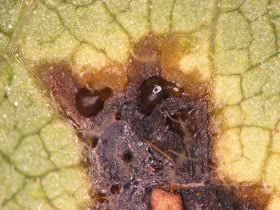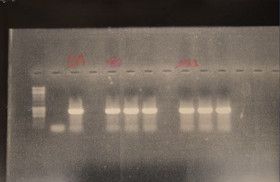A farmer noticed some yellowing leaves in the lower canopy of his field. They were 99.9999999999% sure that it was Septoria brown spot ( Septoria glycines), a common fungal disease of soybeans that occurs in warm and wet weather. This disease rarely causes significant
yield loss; however, yield losses of 5 – 8 % may occur under severe conditions
when much defoliation occurs. This year has been very, wet, so many have chose to make a fungicide application.
As time passed, it appeared that another foliar disease, with different symptoms, started to show in the mid-canopy of this soybean field. The spots were much darker and were more symptomatic of a bacterial disease. The farmer wanted to identify the disease(s), because this would explain why the fungicide was "NOT WORKING". A fungicide will have no effect on bacterial diseases.
As it turns out, the disease that was making it's debut in the mid-canopy was none other but, bacterial pustule (Xanthomonas axonopodis pv. glycines). If you examine the lesion on the underside of the leaf with magnification, you will be able to see pustules forming and this is how we distinguish bacterial pustule from bacterial blight.
However, the Plant Clinic also examined the lesions under the microscope from the leaves that were from the lower canopy of this soybean field. If you remember, these were the yellowing leaves, with lesions that were assumed to be caused by Septoria brown spot. But, when these lesions were cut and placed under the microscope, there were no fungal spores to be found! We found bacterial ooze! The disease in the lower canopy was Bacterial blight (Pseudomonas savastanoi).
 | ||||
| Bacterial ooze seen streaming from the bacterial blight lesion of the soybean. |


.JPG)






